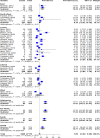The mother-to-child transmission of HIV-1 and profile of viral reservoirs in pediatric population: A systematic review with meta-analysis of the Cameroonian studies
- PMID: 36649370
- PMCID: PMC9844886
- DOI: 10.1371/journal.pone.0278670
The mother-to-child transmission of HIV-1 and profile of viral reservoirs in pediatric population: A systematic review with meta-analysis of the Cameroonian studies
Abstract
Background: The mother-to-child transmission of HIV-1 (MTCT) remains on the major route of HIV-transmission among pediatric populations in Africa. Though a prevention of MTCT (PMTCT) high-priority country, data on the MTCT burdens in Cameroon remains fragmented.
Objective: We sought to assess the pooled MTCT rate, its risk-factors, and to characterize viral reservoirs of infected-children in Cameroon.
Methods: All relevant observational cohort and cross-sectional studies conducted in Cameroon were searched from PubMed, African Journals Online, Google scholar, ScienceDirect and academic medical education databases. Heterogeneity and publication bias were respectively assessed by the I2 statistic and the Egger/funnel plot test. Meta-analysis was performed using the random effects model. MTCT rate >5% was considered as "high". This review was registered in the Prospero database, CRD42021224497.
Results: We included a total of 29 studies and analyzed 46 684 children born from HIV-positive mothers. The overall rate of MTCT was 7.00% (95% CI = 6.07-8.51). According to regions, the highest burden was in Adamaoua-region (17.51% [95% CI:14.21-21.07]) with only one study found. PMTCT option-B+ resulted in about 25% reduction of MTCT (8.97% [95% CI: 8.71-9.24] without option-B+ versus 2.88% [95% CI: 5.03-9.34] with option-B+). Regarding risk-factors, MTCT was significantly associated with the absence of PMTCT-interventions both in children (OR:5.40 [95% CI: 2.58-11.27]) and mothers (OR: 3.59 [95% CI: 2.15-5.99]). Regarding viral reservoirs, a pro-viral DNA mean of 3.34±1.05 log10/mL was observed among 5/57 children and archived HIV drug resistance mutations were identified in pro-viral DNA marker among 21/79 infected-children.
Conclusion: In spite of the dropdown in MTCT following option-B+ implementation, MTCT remains high in Cameroon, with substantial disparities across regions. Thus, in this era of option-B+, achieving MTCT elimination requires interventions in northern-Cameroon. The variation in pro-viral load in infected-children underlines the relevance of characterizing viral reservoirs for possible infection control in tropical settings.
Copyright: © 2023 Ka’e et al. This is an open access article distributed under the terms of the Creative Commons Attribution License, which permits unrestricted use, distribution, and reproduction in any medium, provided the original author and source are credited.
Conflict of interest statement
The authors have declared that no competing interests exist.
Figures









References
-
- UNAIDS. Global HIV statistics: Fact sheet. 2020. www.hiv.gov/hiv-basics/overview/data-and-trends/global-statistics
-
- Directives nationales de prévention et de prise en charge du VIH au Cameroun. Ministère de la santé publique. 2014; 193. https://www.childrenandaids.org/sites/default/files/2017-05/Cameroon_Nat...
-
- World Health Organization. PMTCT strategic vision 2010–2015: preventing mother-to-child transmission of HIV to reach the UNGASS and Millennium Development Goals; 2010. p. 9241599030.
Publication types
MeSH terms
LinkOut - more resources
Full Text Sources
Medical

